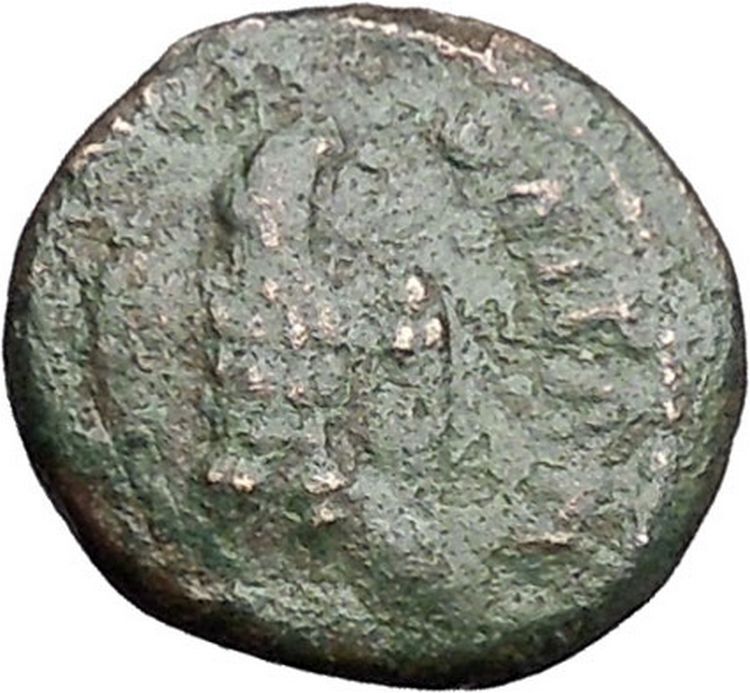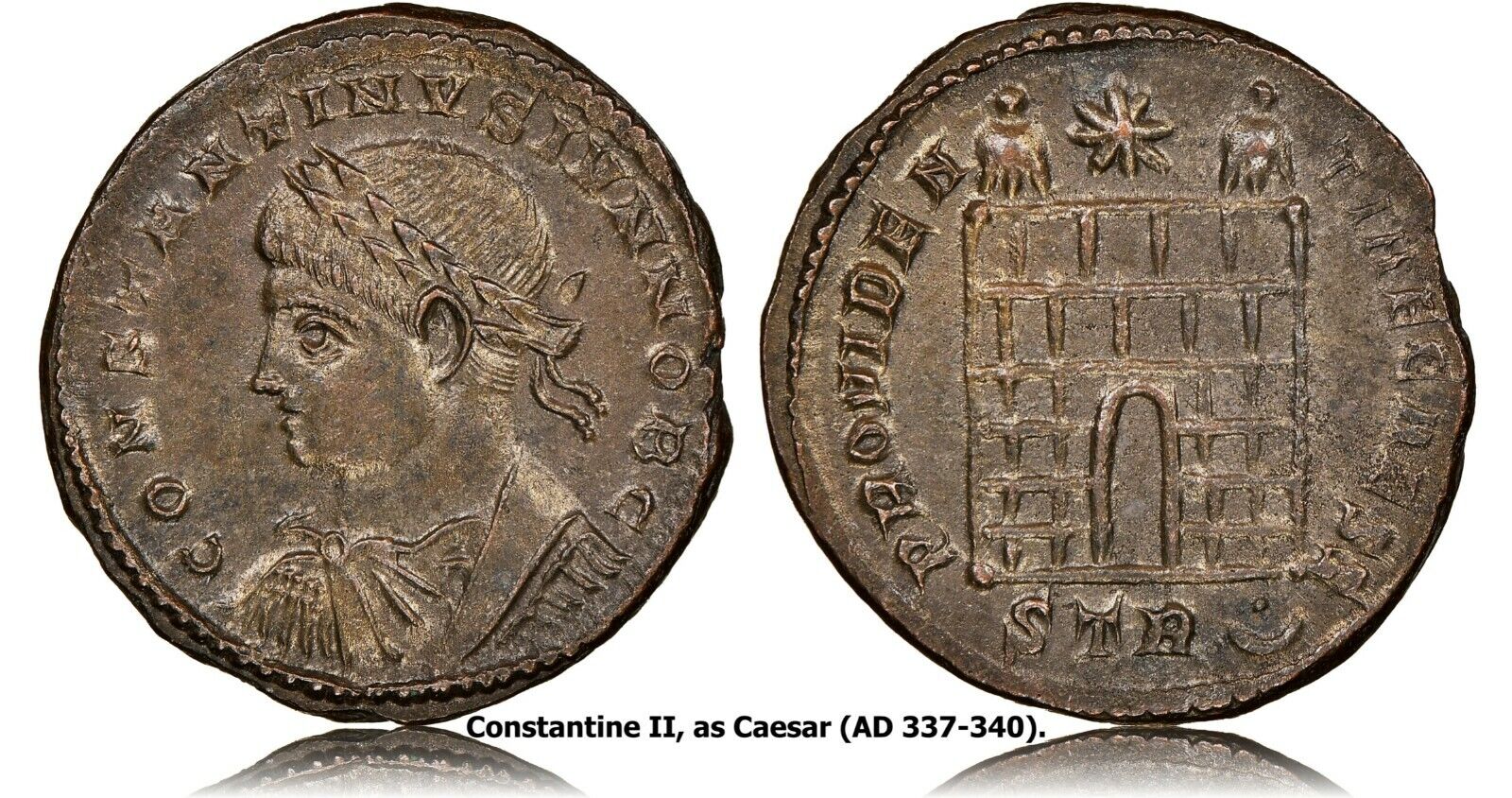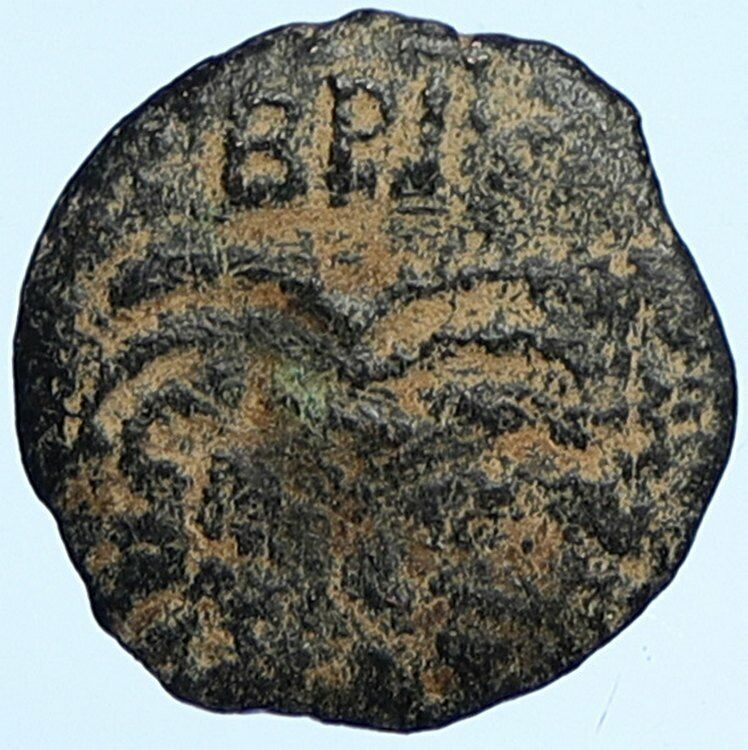-40%
CARACALLA Odessos in Thrace Rare Ancient Roman Coin Great God of Odessos i45426
$ 31.67
- Description
- Size Guide
Description
Item:i45426
Authentic Ancient Coin of:
Caracalla - Roman Emperor: 198-217 A.D. -
Bronze 24mm (6.26 grams) Struck in the Roman provincial city of Odessos
in the province of Thrace -
AVT K M AVP CC OVHPOC ANTΩHIHO - Laureate head right.
OΔHCCEITΩN, Great God of Odessos standing left, sacrificing from patera over flaming altar
to left & holding corucopia. -
Odessos, an ancient Greek (of the city of Miletus) trading colony (apoikia), was founded about 570 BC (in the time of Astyages) on the site of an older Thracian settlement on Cape Varna (in the modern city centre). The name Odessos, first mentioned by Strabo, was pre-Greek, perhaps of Carian origin. Long before the Thracians populated the area (by 1200 BC), prehistoric settlements best known for the eneolithic necropolis, eponymous site of the Varna culture and the alleged world's oldest gold treasure (5th millennium BC radiocarbon dating) existed within the modern city limits, notably along Lake Varna shores. For centuries, Odessos was a contact zone between the urban Ionians and the Thracians (Getae, Crobyzi, Terizi) of the hinterland. By the 4th century BC, it had become a mixed Greco-Thracian community (see also Darzalas).
In 339, the city was unsuccessfully besieged by Philip II but surrendered to Alexander the Great in 335, and was later ruled by his diadochus Lysimachus. The Roman city, Odessus (annexed in 15 AD and included in the province of Moesia, later Moesia Inferior), occupied 47 hectares in present-day central Varna and had prominent public baths, Thermae, erected in the late 2nd century, now the largest Roman remains in Bulgaria (the building was 100 m wide, 70 m long, and 20 m high) and fourth largest known Roman baths in Europe. The city was a Christian centre, as testified by the impressive ruins of early basilicas, monasteries, and indications that apostle Ampliatus (Амплий, Amply), disciple of Saint Andrew, served as bishop there. In 442, a peace treaty between Theodosius II and Attila was done at Odessus.
You are bidding on the exact item pictured, provided with a Certificate of Authenticity and Lifetime Guarantee of Authenticity.
The
cornucopia
(from Latin
cornu copiae
) or
horn of plenty
is a symbol of abundance and nourishment, commonly a large horn-shaped container overflowing with produce, flowers, nuts, other edibles, or wealth in some form. Originating in classical antiquity, it has continued as a symbol in Western art, and it is particularly associated with the Thanksgiving holiday in North America.
Allegorical depiction of the Roman goddess Abundantia with a cornucopia, by Rubens (
ca.
1630)
In Mythology
Mythology offers multiple explanations of the origin of the cornucopia. One of the best-known involves the birth and nurturance of the infant Zeus, who had to be hidden from his devouring father Cronus. In a cave on Mount Ida on the island of Crete, baby Zeus was cared for and protected by a number of divine attendants, including the goat Amalthea ("Nourishing Goddess"), who fed him with her milk. The suckling future king of the gods had unusual abilities and strength, and in playing with his nursemaid accidentally broke off one of her horns, which then had the divine power to provide unending nourishment, as the foster mother had to the god.
In another myth, the cornucopia was created when Heracles (Roman Hercules) wrestled with the river god Achelous and wrenched off one of his horns; river gods were sometimes depicted as horned. This version is represented in the
Achelous and Hercules
mural painting by the American Regionalist artist Thomas Hart Benton.
The cornucopia became the attribute of several Greek and Roman deities, particularly those associated with the harvest, prosperity, or spiritual abundance, such as personifications of Earth (Gaia or Terra); the child Plutus, god of riches and son of the grain goddess Demeter; the nymph Maia; and Fortuna, the goddess of luck, who had the power to grant prosperity. In Roman Imperial cult, abstract Roman deities who fostered peace
(pax Romana)
and prosperity were also depicted with a cornucopia, including Abundantia, "Abundance" personified, and Annona, goddess of the grain supply to the city of Rome. Pluto, the classical ruler of the underworld in the mystery religions, was a giver of agricultural, mineral and spiritual wealth, and in art often holds a cornucopia to distinguish him from the gloomier Hades, who holds a drinking horn instead.
Modern depictions
In modern depictions, the cornucopia is typically a hollow, horn-shaped wicker basket filled with various kinds of festive fruit and vegetables. In North America, the cornucopia has come to be associated with Thanksgiving and the harvest. Cornucopia is also the name of the annual November Wine and Food celebration in Whistler, British Columbia, Canada. Two cornucopias are seen in the flag and state seal of Idaho. The Great Seal of North Carolina depicts Liberty standing and Plenty holding a cornucopia. The coat of arms of Colombia, Panama, Peru and Venezuela, and the Coat of Arms of the State of Victoria, Australia, also feature the cornucopia, symbolising prosperity.
The horn of plenty is used on body art and at Halloween, as it is a symbol of fertility, fortune and abundance.
Base of a statue of
Louis XV of France
In the material culture of classical antiquity, a
phiale
or
patera
(Latin pronunciation: [ˈpatera]) is a shallow ceramic or metal libation bowl. It often has a bulbous indentation (
omphalos
, "bellybutton") in the center underside to facilitate holding it, in which case it is sometimes called a
mesomphalic phiale
. It typically has no handles, and no feet. (A drinking cup with handles is a kylix. A circular platter with a pair of C-handles is not a patera, but a few
paterae
have a single long straight handle.) Although the two terms may be used interchangeably, particularly in the context of Etruscan culture,
phiale
is more common in reference to Greek forms, and
patera
in a Roman setting.
Silver phiale (620-590 BC, from Bayindir village, Elmali, present-day Turkey
Octopus and dolphin motifs on a ceramic phiale (510-500 BC, from Eretria, Euboea)
Golden phiale (4th-3rd century BC)
Silver patera from Hispania (Roman Spain), 2nd-1st century BC)
Use
A youth pours a libation to the deceased within a
naiskos,
a scene that may also represent Ganymede serving Zeus (Apulian red-figure krater, 340-320 BC)
Libation was a central and vital aspect of ancient Greek religion, and one of the simplest and most common forms of religious practice. It is one of the basic religious acts that define piety in ancient Greece, dating back to the Bronze Age and even prehistoric Greece. Libations were a part of daily life, and the pious might perform them every day in the morning and evening, as well as to begin meals. A libation most often consisted of mixed wine and water, but could also be unmixed wine, honey, oil, water, or milk.
The form of libation called
spondē
is typically the ritualized pouring of wine from a jug or bowl held in the hand. The most common ritual was to pour the liquid from an
oinochoē
(wine jug) into a phiale. Libation generally accompanied prayer. The Greeks stood when they prayed, either with their arms uplifted, or in the act of libation with the right arm extended to hold the phiale. After the wine offering was poured from the phiale, the remainder of the contents was drunk by the celebrant.
In Roman art, the libation is shown performed at an altar,
mensa
(sacrificial meal table), or tripod. It was the simplest form of sacrifice, and could be a sufficient offering by itself. The introductory rite
(praefatio)
to an animal sacrifice included an incense and wine libation onto a burning altar. Both emperors and divinities are frequently depicted, especially on coins, pouring libations from a patera. Scenes of libation and the patera itself commonly signify the quality of
pietas
, religious duty or reverence.
Libation at a symposium (Attic red-figure cup, ca. 480 BC)
Apollo pouring a libation (Attic white-ground kylix, ca. 460 BC)
Etruscan priest with phiale (2nd century BC)
Roman priest,
capite velato
(2nd-3rd century AD)
Antoninus (Called 'Caracalla')
Caesar: 195-198 A.D.
Augustus: 198-217 A.D.
( 198-209 A.D. - with Septimius Severus)
( 209-211 A.D. - with Septimius Severus and Geta)
( 211-217 A.D. - Sole Reign)
Caracalla
(April 4, 188 - April 8, 217. Caracallus ), born
Lucius Septimius Bassianus
and later called
Marcus Aurelius Antoninus
and
Marcus Aurelius Severus Antoninus
, was the eldest son of Septimius Severus and Roman Emperor from 211 to 217. He was one of the most nefarious of Roman emperors. Caracalla's reign was notable for:
the
Constitutio Antoniniana
, granting Roman citizenship to freemen throughout the Roman Empire, according to Cassius Dio in order to increase taxation;
debasing the silver content in Roman coinage by 25 percent in order to pay the legions; and
the construction of a large thermae outside Rome, the remains of which, known as the Baths of Caracalla, can still be seen today
"Caracalla was the common enemy of all mankind," wrote Edward Gibbon. He spent his reign traveling from province to province so that each could experience his "rapine and cruelty."
Caracalla's real name was Marcus Aurelius Antoninus. He got the nickname from his habit of wearing a cloak by the same name. Caracalla was the elder son of Septimius Severus and brother of Geta whom he positively hated. Hated so much, in fact, that he had him murdered a few years later. In the mayhem that followed, Caracalla's men went on a killing spree of anyone suspected of being a Geta sympathizer. In the massacre, it's estimated up to 20,000 people lost their lives. Caracalla would go on to rule for another five years but his bad karma caught up with him and he was assassinated in a plot perpetrated by Macrinus.
As an emperor Caracalla possessed few redeeming qualities and among the worst of them would be his ruinous drain on the treasury. Because he knew everyone hated him he sought the protection of the army. And the surest way of getting this protection was to buy it outright. He raised the pay of the solider to about four denarii per day, nearly quadrupling the salary of just a few years prior. And on top of their regular salary he heaped endless bonuses and other concessions meant to endear them. This money could only have come by the oppressive taxation of ordinary citizens as well as the seizures of property of the wealthy under trumped-up charges. This not only intensified the hatred against him but also had the effect of corrupting the military who had become accustomed to this life of luxury and throwing the economy into lasting disarray.
Rise to power
Caracalla, of mixed Punic/Berber and Syrian Arab descent, was born Lucius Septimius Bassianus in Lugdunum, Gaul (now Lyon, France), the son of the later Emperor Septimius Severus and Julia Domna. At the age of seven, his name was changed to Marcus Aurelius Septimius Bassianus Antoninus to solidify connection to the family of Marcus Aurelius. He was later given the nickname
Caracalla
, which referred to the Gallic hooded tunic he habitually wore and which he made fashionable.
His father, who had taken the imperial throne in 193, died in 211 while touring the northern marches at Eboracum (York), and Caracalla was proclaimed co-emperor with his brother Publius Septimius Antoninius Geta. However since both of them wanted to be the sole ruler, tensions between the brothers were evident in the few months they ruled the empire together (they even considered dividing the empire in two, but were persuaded not to do so by their mother). In December 211, Caracalla had Geta, the family of his former father-in-law Gaius Fulvius Plautianus, his wife Fulvia Plautilla (also his paternal second cousin), and her brother assassinated. He persecuted Geta's supporters and ordered a
damnatio memoriae
by the Senate against his brother.
Reign
In 213 Caracalla went north to the German frontier to deal with the Alamanni who were causing trouble in the Agri Decumates. The emperor managed to win the sympathy of the soldiers with generous pay rises and popular gestures, like marching on foot among the ordinary soldiers, eating the same food, and even grinding his own flour with them.
Caracalla defeated the Alamanni in a battle near the river Main, but failed to win a decisive victory over them. After a peace agreement was brokered, the senate conferred upon him the title "Germanicus Maximus". In the next year the emperor traveled to the East.
When the inhabitants of Alexandria heard Caracalla's claims that he had killed Geta in self-defense, they produced a satire mocking this claim, as well as Caracalla's other pretensions. Caracalla responded to this insult savagely in 215 by slaughtering the deputation of leading citizens who had unsuspectingly assembled before the city to greet his arrival, and then unleashed his troops for several days of looting and plunder in Alexandria. According to historian Cassius Dio, over 20,000 people were killed.
During his reign as emperor, Caracalla raised the annual pay of an average legionary to 675
denarii
and lavished many benefits on the army which he both feared and admired, as instructed by his father Septimius Severus who had told him to always mind the soldiers and ignore everyone else. His official portraiture marked a break with the detached images of the philosopher-emperors who preceded him: his close-cropped haircut is that of a soldier, his pugnacious scowl a realistic and threatening presence. The rugged soldier-emperor iconic type was adopted by several of the following emperors who depended on the support of the legions, like Trebonianus Gallus.
[11]
Seeking to secure his own legacy, Caracalla also commissioned one of Rome's last major architectural achievements, the Baths of Caracalla, the largest public bath ever built in ancient Rome. The main room of the baths was larger than St. Peter's Basilica, and could easily accommodate over 2,000 Roman citizens at one time. The bath house opened in 216, complete with private rooms and outdoor tracks. Internally it was decorated with golden trim and mosaics.
The Roman Empire and its provinces in 210 AD
Fall
While travelling from Edessa to begin a war with Parthia, he was assassinated while urinating at a roadside near Harran on April 8, 217 by Julius Martialis, an officer in the imperial bodyguard. Herodian says that Martialis' brother had been executed a few days earlier by Caracalla on an unproven charge; Cassius Dio, on the other hand, says that Martialis was resentful at not being promoted to the rank of centurion. The escort of the emperor gave him privacy to relieve himself, and Martialis ran forward and killed Caracalla with a single sword stroke. He immediately fled on horseback, but was killed by a bodyguard archer.
[
citation needed
]
Caracalla was succeeded by the Praetorian Prefect of the Guard, Macrinus, who almost certainly was part of the conspiracy against the emperor.
His nickname
According to Aurelius Victor in his
Epitome de Caesaribus
, the cognomen "Caracalla" refers to a Gallic cloak that Caracalla adopted as a personal fashion, which spread to his army and his court. Cassius Dio and the
Historia Augusta
[14]
agree that his nickname derived from his cloak, but do not mention its country of origin.
Caracalla and Geta by Lawrence Alma-Tadema. 1907.
Legendary king of Britain
Geoffrey of Monmouth's legendary
History of the Kings of Britain
makes Caracalla a king of Britain, referring to him by his actual name "Bassianus", rather than the nickname Caracalla. After Severus's death, the Romans wanted to make Geta king of Britain, but the Britons preferred Bassianus because he had a British mother. The two brothers fought a battle in which Geta was killed, and Bassianus succeeded to the throne. He ruled until he was betrayed by his Pictish allies and overthrown by Carausius, who, according to Geoffrey, was a Briton, rather than the Menapian Gaul that he actually was.
Frequently Asked Questions
How long until my order is shipped?:
Depending on the volume of sales, it may take up to 5 business days for shipment of your order after the receipt of payment.
How will I know when the order was shipped?:
After your order has shipped, you will be left positive feedback, and that date should be used as a basis of estimating an arrival











